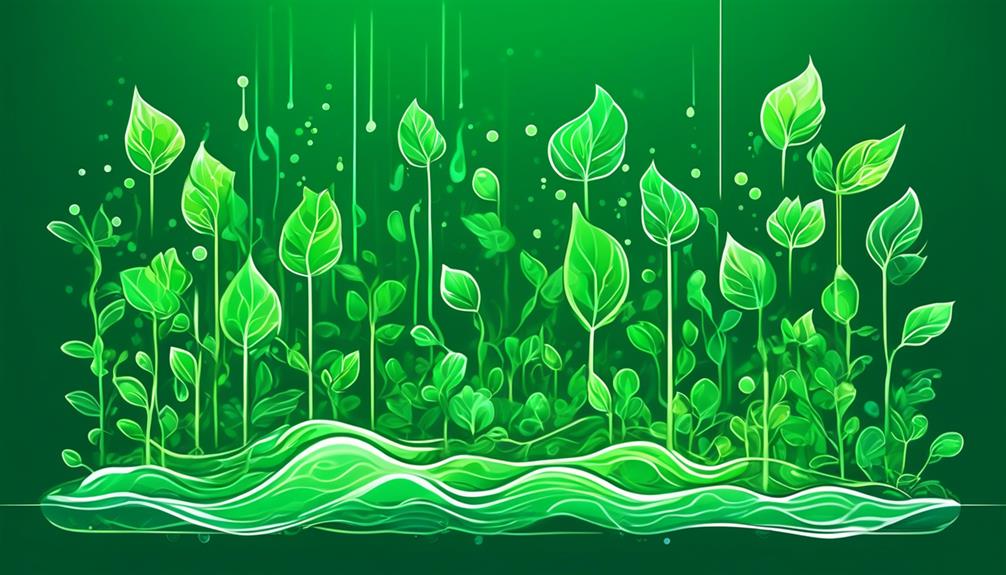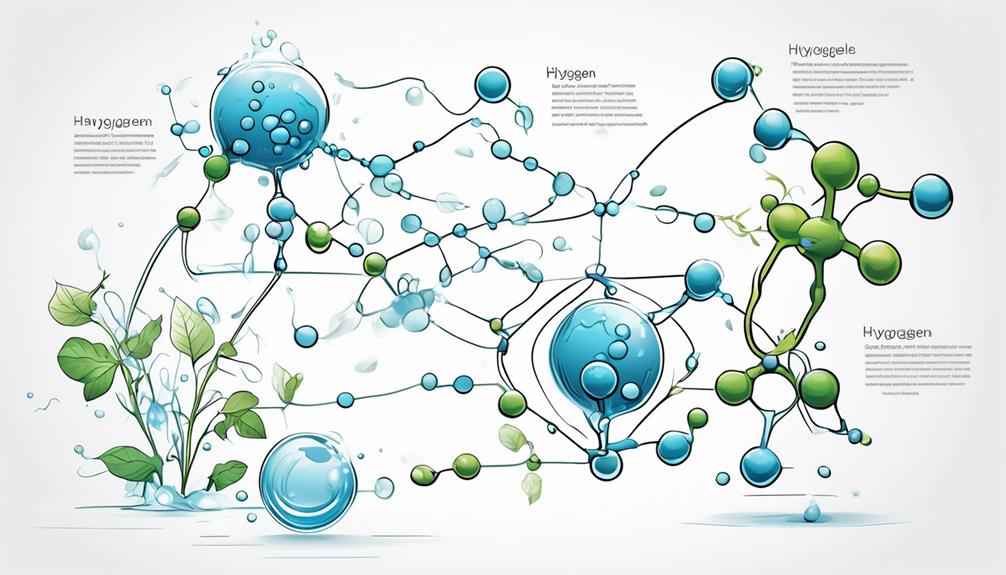Imagine water as the silent conductor orchestrating a grand symphony within the green realms of nature. In the intricate dance of photosynthesis, water's role is not merely that of a bystander; it is a vital player in the conversion of light into life.
As you begin to unravel the complexities of water's involvement in this fundamental process, you will uncover a tapestry of interconnected mechanisms that hold the key to sustainable energy solutions and a deeper understanding of the very essence of life itself.
Key Takeaways
- Water is essential for sustaining cell functions and facilitating crucial chemical reactions within cells.
- Water plays a vital role as a reactant in photosynthesis by donating electrons, producing oxygen, ATP, and NADPH.
- The process of water's electron donation and splitting is integral for driving ATP and NADPH production in photosynthesis.
- Water's involvement in electron transport and photosynthetic efficiency directly impacts plant productivity and growth, emphasizing the significance of water in the photosynthesis process.
Importance of Water in Photosynthesis
Water's pivotal role in photosynthesis can't be overstated, as it's essential for sustaining cell functions and facilitating crucial chemical reactions within cells. In the photosynthesis process, plants harness the energy from sunlight to convert carbon dioxide and water into glucose and oxygen.
Light energy is absorbed by chlorophyll in plant cells, initiating the complex biochemical reactions that culminate in the production of glucose. Water plays a fundamental role in this process by providing the electrons necessary for the conversion of carbon dioxide into glucose. Additionally, water serves as a source of hydrogen ions, contributing to the formation of oxygen molecules during photosynthesis.
Without water, plants would be unable to generate the energy they need for growth, maintenance, and reproduction. Thus, the importance of water in photosynthesis can't be emphasized enough, highlighting its crucial role in sustaining life on Earth and the significance of understanding its involvement in this vital biological process.
Structure of Water Molecules
In understanding the significance of water's role in photosynthesis, it becomes imperative to grasp the composition and properties of water molecules, particularly their unique structure. The structure of water molecules consists of two hydrogen atoms and one oxygen atom, forming a polar molecule. This polarity enables water to form strong bonds with other polar molecules, making it a universal solvent crucial for various cellular functions. Here is a breakdown of the structure of water molecules:
| Hydrogen Atom | Oxygen Atom | Hydrogen Atom |
|---|---|---|
| O | ||
| H | – | H |
| H |
Water's role in the photosynthetic electron transport chain is vital as it reacts and is oxidized during the photosynthesis process. This process takes place when water molecules are split, and oxygen is released as a byproduct. Understanding the structure of water molecules provides insight into how water's unique properties drive essential biological processes.
Water's Role as a Reactant
Water plays a crucial role as a reactant in photosynthesis by donating electrons during the light-dependent reactions. Through the water-splitting process, it provides electrons needed to fuel the photosynthetic electron transport chain.
This process not only produces oxygen but also generates essential molecules like ATP and NADPH for further stages of photosynthesis.
Water's Electron Donation
During the light-dependent reactions of photosynthesis, electrons from water play a crucial role in generating oxygen and protons. As water molecules are split, they provide electrons that are essential for replenishing those lost from photosystem II, crucial for the electron transport chain. This electron flow is integral to the transfer reactions that lead to the release of oxygen as a byproduct.
The electron transfer from water to the photosynthetic machinery allows for the conversion of light energy into chemical energy.
Water's electron donation drives the production of ATP and NADPH, vital for plant growth and survival.
The process of taking up water and using its electrons sustains the energy production needed for carbon assimilation in photosynthesis.
Water Splitting Process
Indispensable for the light-dependent reactions of photosynthesis, the process of water splitting involves breaking down H2O into oxygen, protons, and electrons. Within Photosystem II (PSII), water splitting occurs as a crucial step in the photosynthesis process.
When light is absorbed by the PSII antenna size, it triggers a series of redox reactions that lead to the separation of water molecules. This splitting of water not only produces oxygen necessary for aerobic life but also supplies electrons to replace those lost in the reaction center of Photosystem II.
Additionally, the protons released during water splitting aid in establishing a proton gradient essential for ATP synthesis, ultimately fueling cellular activities. Water's role as a reactant in this process is fundamental for sustaining life through the generation of energy-rich molecules.
Water's Involvement in Electron Transport
In the intricate process of photosynthesis, the role of water in electron transport is fundamental for converting light energy into chemical energy. Within the chloroplasts of plant cells, water molecules are split during the light-dependent reactions on the thylakoid membrane. This splitting of water provides the necessary electrons that are then shuttled through the photosynthetic electron transport chain.
This movement of electrons generates a proton gradient, which is crucial for the production of ATP, the primary energy carrier in biological systems. Understanding the significance of water's involvement in electron transport not only elucidates the complex mechanisms of photosynthesis but also holds potential for applications in sustainable energy solutions.
The release of oxygen as a byproduct from the process of water oxidation is essential for sustaining aerobic life on Earth, highlighting the interconnectedness of all living organisms with the process of photosynthesis.
Water's Impact on Energy Conversion

Water, with its unique properties, plays a crucial role in facilitating energy conversion processes within cells. Its polarity allows water to engage in essential chemical reactions, supporting various types of energy conversion within cells.
In photosynthesis, water is vital for the oxidation of water molecules, releasing oxygen and enabling plants to convert energy in the form of light into energy stored in glucose. Water's ability to act as a universal solvent ensures that crucial reactions occur smoothly, aiding in the efficient conversion of energy during photosynthesis.
The stable chemical bonds in water play a significant role in sustaining energy conversion processes, particularly in photosynthesis, where water's adaptability as an acid and a base is fundamental.
Significance of Water in Oxygen Evolution
Regularly overlooked but fundamentally significant, water's pivotal role in oxygen evolution is paramount to the intricate process of photosynthesis. As you delve into the significance of water in oxygen evolution, consider the following:
- Electron Donor: Water serves as the primary electron donor in photosystem II (PSII), facilitating the conversion of carbon dioxide into energy-rich organic compounds.
- Oxygen Release: The oxidation of water during photosynthesis leads to the release of oxygen, which is essential for sustaining aerobic life on Earth.
- Energy Production: The splitting of water molecules in the light-dependent reactions generates protons, electrons, and oxygen, contributing to the production of ATP and NADPH, crucial for driving the synthesis of carbohydrates in the Calvin-Benson cycle.
Understanding the role of water in oxygen evolution not only sheds light on the intricate workings of chloroplasts but also paves the way for advancements in artificial photosynthesis and sustainable energy solutions. Water's involvement in this process underscores its irreplaceable contribution to the production of chemical energy essential for life.
Water's Influence on Chlorophyll Fluorescence

Water plays a vital role in the chlorophyll fluorescence process, influencing how photosynthesis functions.
It affects the mechanism behind chlorophyll fluorescence and impacts the overall photosynthetic process.
Understanding how water influences chlorophyll fluorescence can provide valuable insights into the efficiency of photosynthesis in plants.
Chlorophyll Fluorescence Mechanism
Influencing the chlorophyll fluorescence mechanism, water's arrangement of hydrogen and oxygen atoms plays a crucial role in photosynthesis. The polar nature of water allows it to interact with chlorophyll within the chloroplasts, impacting the fluorescence properties. This interaction is essential for the functioning of the Calvin cycle, ATP synthesis, and the production of NADPH.
Water's involvement in the cyclic electron flow during photosynthesis directly affects the chlorophyll fluorescence mechanism. Understanding how water influences chlorophyll fluorescence provides valuable insights into the efficiency of photosynthetic processes. By grasping the significance of water's role in photosynthesis, scientists can delve deeper into improving the overall efficiency of this vital biological process.
Water's Impact on Photosynthesis
Playing a pivotal role in influencing chlorophyll fluorescence, water's impact on photosynthesis is essential for understanding the efficiency of the process. Water, within chloroplasts, participates in the light-dependent reactions of photosynthesis, particularly in Photosystem II (PSII). Through the process of photolysis, water is split to release oxygen and electrons, which are crucial for the generation of ATP and NADPH, essential for the Calvin Cycle. The presence of water affects the quantum yield of photosynthesis, influencing the overall productivity of the plant. Water deficit can disrupt these processes, impacting plant growth and productivity. By studying chlorophyll fluorescence and gas exchange, researchers gain insights into water's impact on photosynthesis and plant stress responses.
| Water's Impact on Photosynthesis | ||
|---|---|---|
| Key Concepts | Examples | Effects |
| Photolysis in PSII | Oxygen release from water | ATP and NADPH production |
Regulation of Water in Photosynthesis
Regulating the availability of water for photosynthesis involves intricate processes within plant leaves, impacting the overall efficiency of this vital biological mechanism. The regulation of water in photosynthesis is essential for maintaining the functionality of the photosynthetic system. Here are some key points to consider:
- Stoma Function: The stoma, tiny openings on the leaf surface, play a crucial role in regulating water uptake. They control the exchange of gases, including water vapor, affecting the availability of water for photosynthesis.
- Chloroplast Activity: Within the chloroplasts, the organelles responsible for photosynthesis, water is a key component in the process of converting light energy into chemical energy. Proper water regulation ensures that this energy is efficiently absorbed and utilized.
- Impact on Photosynthetic Efficiency: Water deficit can disrupt the electron transport chain in photosynthesis, leading to a decrease in the photosynthetic rate. Understanding and managing water levels are crucial for optimizing plant productivity.
Maintaining a balance in water regulation is fundamental for the optimal functioning of the photosynthetic process and overall plant health.
Modeling Water's Functions in Photosynthesis

Water's pivotal role in photosynthesis becomes evident through its fundamental properties and interactions within plant cells. Within chloroplasts, where photosynthesis occurs, water plays a crucial part in the light-dependent reactions. As light strikes Photosystem II (PSII), water molecules are split through photolysis, releasing oxygen as a byproduct and providing electrons to fuel the electron transport chain. This process generates ATP and NADPH, essential molecules for the subsequent steps of photosynthesis.
Moreover, water acts as a source of hydrogen ions, which are utilized in the formation of NADPH during the light-dependent reactions. The oxygen released during the photolysis of water contributes to the oxygen production essential for life on Earth. By modeling water's functions in photosynthesis, researchers gain insights into how this molecule sustains the intricate process of converting light energy into chemical energy. Understanding water's multifaceted roles in photosynthesis is crucial for harnessing this natural phenomenon to develop sustainable energy sources.
Frequently Asked Questions
What Is the Role of Water in the Process of Photosynthesis?
In photosynthesis, water plays a crucial role by providing electrons needed for the light-dependent reactions. It also releases oxygen essential for life. Understanding water's significance in photosynthesis is vital for sustainable energy solutions and optimizing natural processes.
What Is Water's Role in the Light Reaction of Photosynthesis?
In the light reaction of photosynthesis, water plays a crucial role by providing electrons through photolysis. These electrons are essential for generating ATP and NADPH. Think of water as the spark that ignites the energy production process in plants.
How Does Water Affect Photosynthesis?
Water affects photosynthesis by being a critical component in the process. It's oxidized to release oxygen and produce glucose. Without enough water, plant gas exchange, growth, and crop productivity suffer, impacting photosynthesis efficiency.
What Is the Role of Photosynthesis in the Water Cycle?
In the water cycle, photosynthesis plays a vital role by releasing oxygen from water molecules during the process. This oxygen contributes to the atmosphere, while water's participation in photosynthesis provides electrons and protons for energy production.
Conclusion
As you reflect on the intricate dance between water and photosynthesis, picture a shimmering stream winding through a sun-dappled forest.
Just like how water flows through plants, nourishing them with life-giving energy, it also flows through the process of photosynthesis, fueling the creation of oxygen and glucose.
The beauty of nature's design is revealed in the symbiotic relationship between water and photosynthesis, a harmonious symphony of life and energy intertwined.